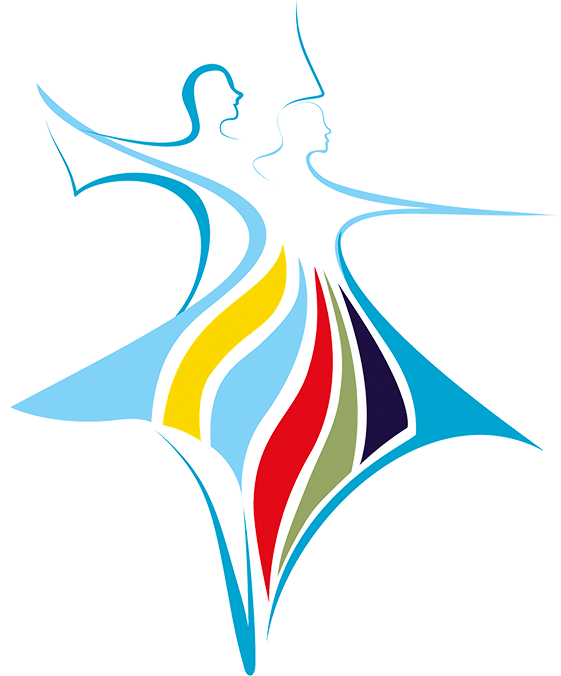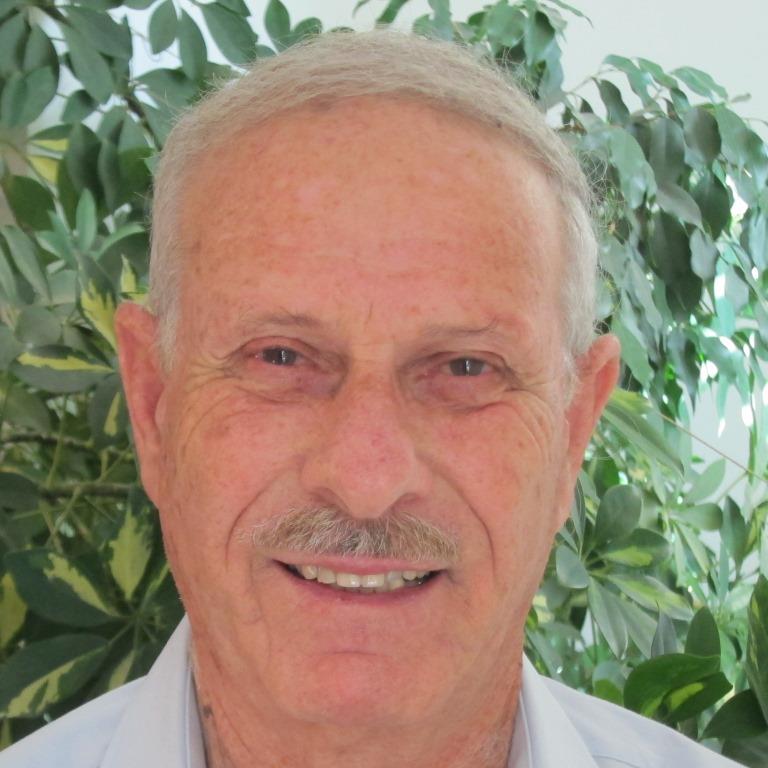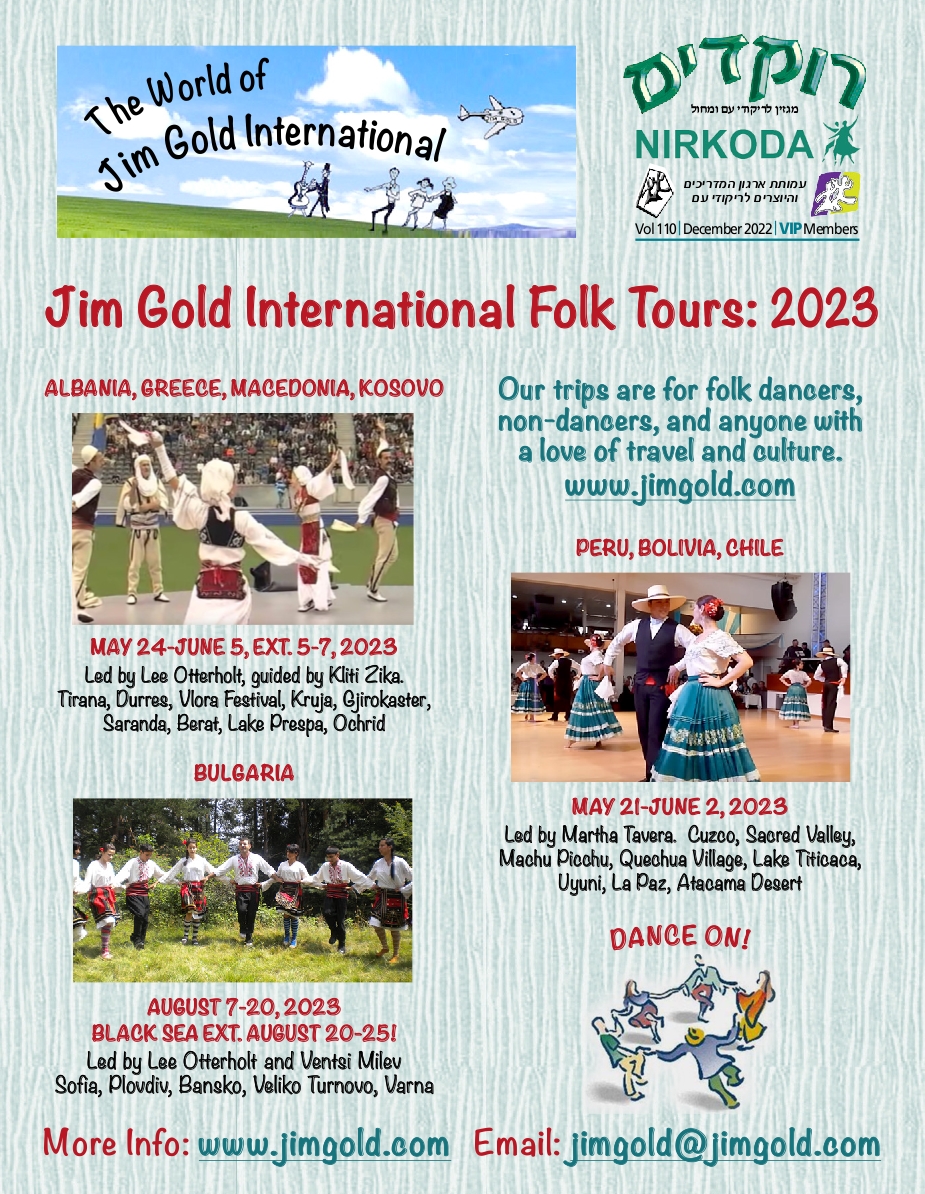- Home
- Rokdim Nirkoda 110
- The Three Worlds Of Ruth Pardes
The Three Worlds Of Ruth Pardes
Psychologist, Dancer and Folklore Researcher
- Translation: Alex Huber
Ruth Pardes can be characterized by a variety of outfits:
One outfit is in line with her official paramedical practice in the field of psychotherapy. She chaired the Israeli Association for Creative Arts Therapies (YAHAT) where she fought to receive professional recognition for the field (Therapists through the Arts), a well-tailored outfit evoking importance and prestige.
A light, ornate, stylish second outfit – marks her occupation with movement therapy, and folk dance, with its enormous diversity.
A third outfit – a kind of scientist’s cloak – the researcher of Jewish folklore in different communities and cultures.
These outfits, as symbols, are the holistic expression of the three worlds of this colorful woman, a woman without limits. And beyond the occupations and specialties, there is also an extraordinary life story as will be told in this article.
After driving the winding road in a forest, we met at her special home in the village of Hararit, in the Regional Council of Misgav, in the Galilee. Standing at the entrance to her home, to the sides of the sidewalk there were cyclamens and other flowers and abundant vegetation full of greenery and trees. Nira, my partner, and I, felt a magical peace, flowing energies, a calm air, and the presence of respectful hospitality.
The house itself inspires comfort and wonder. The unique 5-sided structure (golden pentagon) designed by Joe Pardes, Ruthy’s late husband, overlooks the Beit Netofa Valley and the Sea of Galilee, a sprawling landscape that is calm and breath-taking.
Breakfast is already prepared on the custom designed table, because that’s the ritual of hospitality in this house, “The Ruthy and Joe Pardes House”. The walls are covered with large wall pictures and sculptures are scattered in various corners, all created by the very creative lady of the house.
The entire interview lasted about four hours, accompanied by dance demonstrations and explanations that even included changing costumes for more authentic demonstrations. The family albums starred in the flowing conversation, with nostalgic photos of many years throughout the country and the world of an active life. We left her house overwhelmed with culture, and positive energies. We had enriching and powerful experiences.
In a comprehensive interview, which is too short to contain the scope of this little/big woman’s achievements, Ruth lays out the history of her accomplishments in the 82 years of her life.
Chapter One – Psychotherapy as a central occupation in life.
For the past 50 years, Ruth has been practicing psychotherapy within the framework of the “Israeli Association for Creative Arts Therapies”. This organization, which represents the therapists vis-à-vis the state, brings together experts in the field of art therapy in 6 disciplines: visual arts, bibliotherapy, drama, music, psychodrama, movement and dance. The organization currently operates in Israel under the Department of Education, Health and Welfare. Thanks to the efforts of Ruthy and her partners, the industry gained professional recognition, a process that continues today.
Ruth acquired her early professional education at the Seminar Ha’Kibbutzim (Kibbutzim College) and later completed a master’s degree in clinical psychology at Bar Ilan University. An additional master’s degree in movement therapy was acquired by Ruthy in England. Subsequently, she specialized in movement therapy and dance at the Dance Therapy Academy, in Germany and at the University of Haifa. Ruth worked for many years at Shamir Medical Center (Assaf Harofeh) diagnosing and rehabilitating children suffering from CP (cerebral palsy). She worked as a psychotherapist the hospital in Be’er Ya’akov for 20 years.
For eight years, Ruth served as national chairperson of YAHAT and held a special certificate of appreciation for her contribution to this important association, an association that grew under her leadership to thousands of members in each of the association’s fields of activity.
Medical Therapy and Dance – Yes, They Go Together
Ruthy describes the duality of her life: Most of my life I have been torn within myself because of my beginning. Dance has been ingrained in me since the beginning of time. Even when I was a child in Kibbutz Negba, at the age of 5, these skills were identified. Negba is where I had my first solo in a dance performance. I haven’t stopped since.
In parallel with my therapeutic work, dance was all my world. As a teenager, I was sent to study with Gertrud Kraus and artistic training with Aryeh Kalev. I participated in drumming workshops by Eliyahu Gamliel and in Debka dancing with Viki Cohen. I was drafted by Raya Spivak and Tirza Hodes to a training course for dance leaders at the Beit Lessin studio.
Later, I was invited to teach in the ulpan (Dance Leaders training course). Later I also managed the course at Beit Lessin and at the same time at Givat Washington. Work in which I continued for 30 years.
My partners in establishing the folk dance enterprise in Israel, who deserve to be mentioned were the leaders in the field – Gurit Kadman, Rivka Shturman, Yoav Ashriel, Eliyahu Gamliel, Shalom Hermon, Yankele Levy, Tamar Alyagor, Moshiko Halevy, Yonatan Gabay, and Yonatan Karmon.
Interpretation and investigation are the essence of folklore – Ruth’s story
Ruthy: I opened large and successful dance sessions (chugim), and I swept crowds to dance and have fun. My track record includes great choreographies (below), but I was particularly interested in the study and interpretation of movement and dance, as well as the communication that takes place among people during the dance. I focused on interpreting what is a good dance – structure, steps, belonging, beginning, high point and end: what makes the excitement and what brings the enthusiasm in dance.
Why, for example, the hands raise and the head moves here or there. What are the origins of the movements, distinctions and separations, what is the theory behind leading and how to correctly teach each step. As a model, I focused on Yemenite dance. I attached great importance to the ethnic origin of dance and the cultural expression inherent in it. And I especially researched the Yemenite Henna ceremony and the healing rituals within it.
At the same time, I also studied the characteristics of Middle Eastern/Oriental and Eastern European Jewry: what connects the movement of the knees in the Yemenite style, for example, to the bending of the knees in Chassidic dance. I was assisted by Dr. Zvi Friedhaber and his extensive knowledge. I examined how dance relates to customs such as ascension to the tombs of the righteous, revelations, Lag BaOmer in Meron, weddings, jewelry, eye coloring, etc.
I researched Moroccan literature and others in order to be precise in the expression of movement and dance. I saw, for example, in Yemenite dance small movements up and down, with the piyyut of Shalom Shabazi, the melody and the movement connected as touching God and holiness. I learned to understand through the Arab Debka, for example, in which the hands are strongly connected as a chain, expressing power that is projected from one to the other. This is typical of a cohesive Arab society, close-knit, connected to the ground with the man leading because such is the patriarchal society.
I’ve seen characterization of the “Yekim”(those of German origin) culture in the dances of Shalom Hermon, Rivka Shturman, Gurit Kadman in dances like “Bat Yiftach”, “Hora Neurim”, a more rigid “square” pattern. I learned the dances of the “Chassidim” from Eastern Europe. The foods, the clothing, the Ladino language and much more. Gurit Kadman became my guru and Tirza sent me to teach and study all over the country.
At one point, I was sent to teach Israeli folk dance to new “Olim” at their settlements. I learned more from them than I taught. I learned the customs of the communities, the foods, the movements, the clothes, the holidays. Later, based on this knowledge, I based my therapeutic work, and the creation of a therapeutic model that draws its strength from the patient’s own cultural origin.
Harkadot and Chugim (Dance sessions and Classes)
Ruth had a large Harkada, with hundreds of dancers, at Beit Milman in Tel Aviv. She was very popular among folk dance lovers. She organized family gatherings of her dancers in Kfar Hayarok to form close acquaintances. She had a good class at Beit HaSofer in Tel Aviv and held major Harkadot from Metulla to Eilat. Her lehakot (dance troupes) have performed in different parts of the country. At the Karmiel Dance Festival, Ruthy opened the evening of Harkadot for years, and was part of the festival’s judging committee.
The Story of the French Chapter and the Activity around the World
One day, a French girl named Kristian came to my class at Beit Milman. It turned out that she was looking for sources in the world of folklore. She was deeply impressed by what she saw and invited me to teach in France. I conducted dance seminars in Grenoble, Toulouse, and in Vallauris on the French Riviera. Seminars that included an array of Israeli Ethnic symbols. It included our food, lectures, stories of our country and the Israeli experience. Together with my husband Joe, we created A unique Israeli experience of eating, drinking and dancing, which became a huge Zionist cultural enterprise for 30 years. Joe was the living spirit behind this great enterprise. Over the years, I believe that because of it, hundreds of people have become loyal advocates for our country. This has given us a great sense of satisfaction.
Does not stop for a moment
In Ruth’s house there is a studio, which besides being a dance and movement studio, is also an interesting museum. Large murals, historical pictures, a meditation corner and more for the spirit and soul. A clinic for yoga groups takes place here as well as workshops dealing with transitions in life and in the community. Of course, there are Individual and group sessions on various topics, under the guidance of Master of Psychotherapy Ruth Pardes. In addition, Ruthy created a show, “Life story meets dance”, which she presents in the studio at her home.
An unbelievable life story of St. Antoshka
Ruth Schwartz (later Vatash and then Pardes) was born in the ghetto in Ostrowitz (Ostrowiec), Poland, in February 1940. With the German occupation, the danger increased, and her mother decided to save her two-year-old daughter. Mother Guta worked outside the ghetto as a cook serving SS officers. Once the girl disappeared from her mother’s eyes and it turned out that she was dancing in front of the officers.
The mother realized that she had to save the girl and at a certain moment, with prior coordination, handed her over to a German-Polish officer named Aloja Plava, who pulled out the baby wrapped in something, over the barbed wire fence of the ghetto. The man gave the girl to his parents who lived in a nearby village, a pro-Nazi village. He explained to them that it was his daughter who was born to him illegally. His parents gave her the name Antoshka. She was baptized into Christianity and became a granddaughter in every respect.
In 1945, after Mother Guta survived the war, she returned to take her daughter, who, of course, did not know her. She came to the scene pretending to be a Polish teacher, who collects children who remained in the villages during the war. She took the girl and disappeared with her from the village. Later, she immigrated to Israel, settled in Tel Aviv and sent the girl, under her new name, Ruth, to Kibbutz Negba.
At the end of the war, the Russians reached the area where the villages that helped the Germans in the war were. The Russians retaliated by destroying the villages, thereby settling the murderous account with the Nazis. The residents of this village told the Russians about the girl who was saved from the clutches of the Nazis thanks to them. The Russians took pity on the village thanks to that girl whom they saved. The people of the village attributed the saving of their village to the girl, Antoshka, and made her a local saint. In her honor, they erected a special cross on top of a hill where they make a pilgrimage every year as a tribute to Saint Antoshka. A few years ago, Ruth Pardes went to that village and was greeted with celebrations of joy and admiration in a special ceremony with the community leaders of the city.
Later, the Mother Guta went to Poland and found the officer who saved her daughter. In 1978, Officer Plava was brought to Israel and was bestowed the title of “Righteous Among the Nations”. He never married, remained childless and did not want any reward in return for his actions. Yet, the photo of the girl, Antoshka, always remained in his pocket.
Ruth has two sons, Chai and Gal, from her first husband, Tuvia Vatash. For most of her years she lived with her second husband, her great love, Joe, who passed away a few years ago, and his two daughters, Yael and Orna. Ruth and Joe have 10 grandchildren and a great-grandchild.
Ruthy continued her life with her partner, Uri. Their love created a wonderful relationship over the past four years that ended painfully with Uri’s death.
Ruthie continues to say, “yes to life”, and inspires with her ability to cope with what life brings.
Ruth Pardes’ acquaintances and admirers talk about her, in short interviews for this article
Moshiko Halevy, Choreographer, Composer, Poet, Dancer and former Director of the Inbal Dance Company:
I have known Ruth for many years, including special gatherings. Ruth is a spiritual woman, a soul. Her love for dance is something special. I know that during her many trips to France, where she held workshops, she also took my dances as materials for her study program there. I’m proud of that. I have always appreciated her spiritual approach in her professional work.
Shlomo Maman, Choreographer, the Artistic Director of the Karmiel Dance Festival for years:
I remember Ruth very well from her legendary Harkada at Beit Milman, where I also danced with her. She is a gifted instructor with many years of knowledge and experience. Eloquent in her speech, every word clear and measured. She also danced beautifully. Above all, Ruth reveals a deep knowledge of the basics of dance and the research of its origins. Ruth always shines in the center of the circle with her outer and inner beauty.
Yoav Sidi, Dance Instructor, is engaged in the documentation and preservation of Israeli folk dance history:
Ruth is a very experienced instructor with her unique characteristics. It’s not just the steps; it’s mainly the nature of the dance and deepening the layers of understanding of the essence of the steps and the choreography. Her special distinction is an additional layer above what is visible to the ordinary eye. For years she contributed another dimension to the organization of the harkadot (dance sessions) at the Karmiel Festival.
Tuvia Tishler, Choreographer, Dance Leader:
Ruth’s thoroughness is in its essence. Each step is precise and meticulous. I saw her at work when I was teaching with her at Blue Star Camp in the United States. With her, it is not just the learning of the dance, but also her ability to tell the story of the dance, its history, how it was created, what its meaning is and what it symboizes.
Aliza Rosen, Dance Leader, Producer, Journalist:
Ruth is a captivating personality, close to perfect. For her, it’s not just dance, it’s an entirely holistic experience – it’s friendship, support, partnership, interest in you and evaluating the person with developed senses. For example, joining hands in a circle, the connection between people in every sense. She will always ask you what else is needed, what to give, what to get – a two-way relationship. As far as she is concerned there is no “simple” in life; everything has its purpose. And above all Ruth is very, very talented.
Yigal Triki, Dance Leader, Dance Instructor’s Course Manager:
Ruth’s way of instructing – pleasant, gentle and understanding. There are some who shout, act tough or scary, while teaching. Not so with Ruth; she strives for perfection – raise your hand this way and not that way, pay attention to the knees, the correct circular movement, (as in the dance “Bo Beshalom”, for example, or the movement of sowing). It is not enough to do the required movement; it must be done beautifully and fitting in relation to the meaning and the step. Yes, I learned a lot from her.
Raya Spivak, Choreographer, Dance Leader, Producer:
I was the one who set Ruth off towards folk dancing. After the time in Kibbutz Negba, the girl who was looking to find herself, came to me and accepted my hug. Ruth followed my footsteps in other areas. She is talented and endowed with dynamism, vigor and energy in the full sense of the word. A very good dancer and a gracious instructor. She also instructed in the Ulpan (course) for folk dance instructors. Being younger than us, in a way she is Tirza Hodes’ and my foster child. She is not number one, she is one and a half!
This is the story of the multi-talented Ruth Pardes, one of the leaders in the field of Israeli dance, who has a place of honor in the culture of Eretz Israel.









Comments
התראות